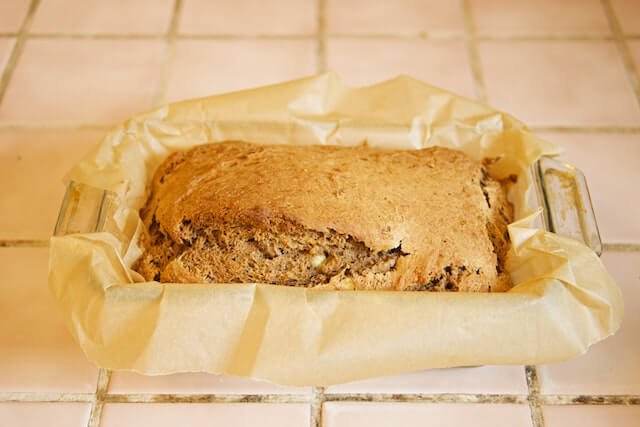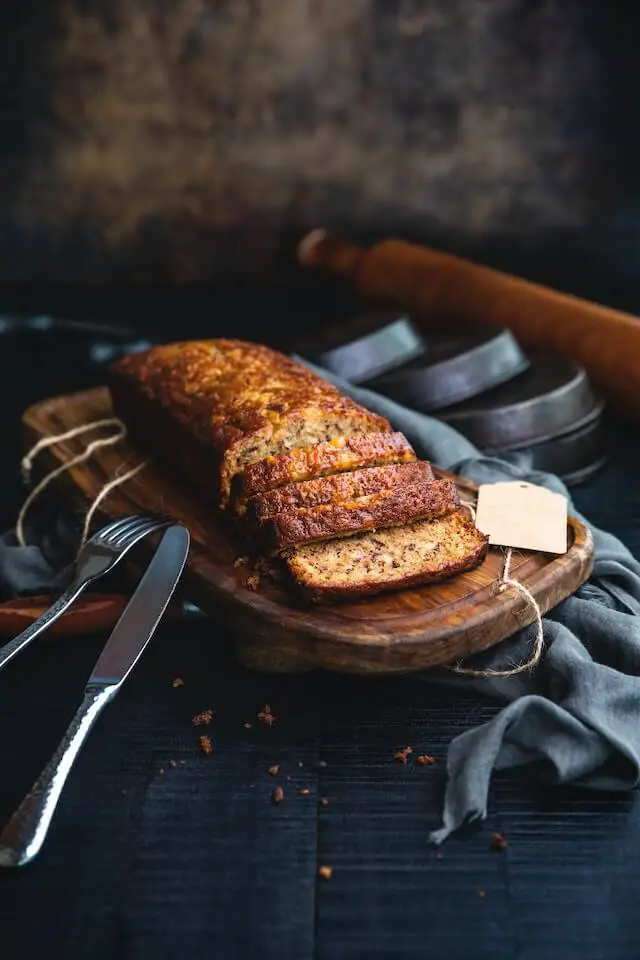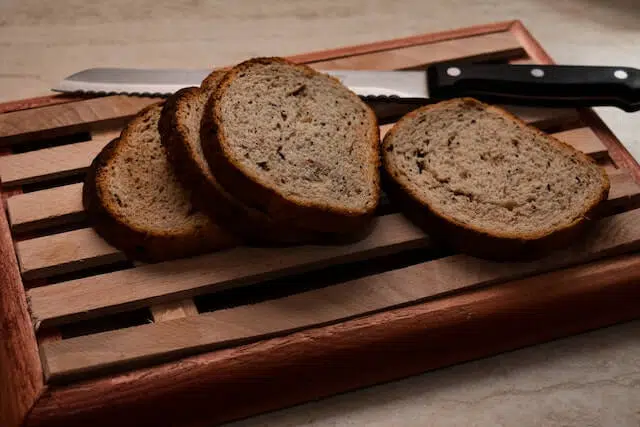Are you tired of making banana bread that comes out rubbery or dense and seeking ways on how to fix rubbery banana bread? Fear not, because help is at hand! In this blog post, I’ll be sharing a few easy fixes that will ensure your banana bread is nothing but moist and fluffy.
Banana bread is a classic baked treat, but even the most experienced bakers can struggle with getting it just right. I’ve compiled a list of common mistakes and simple solutions to help you create the perfect banana bread each time.
Whether you’re an expert baker or a novice, I’ve got you covered! So, grab a cuppa of coffee, and let’s get started on creating that delicious banana bread.

Table of Contents
ToggleWhy Is My Banana Bread Rubbery And How To Fix Rubbery Banana Bread?
Now, let’s understand the causes of rubbery banana bread and learn effective strategies to fix them.
1. Overmixing The Batter
Overmixing the batter is a top reason for rubbery banana bread; it causes flour gluten to develop like regular bread, making it bouncy and tough.
2. Mixing The Wet And Dry Ingredients At The Same Time
To prevent rubbery texture in banana bread, it’s crucial to avoid mixing the wet ingredients and dry ingredients simultaneously. Start by combining flour and sugar separately, then add them to the wet mix.
Use a wooden or metal spoon and gently stir from the center until just combined. Don’t worry about small lumps; these are often bits of banana that will cook down during baking.
3. Adding Too Much Banana
Adding too much mashed banana to the mix can make banana bread rubbery due to extra moisture, leading to a soggy texture.
This often requires extra mixing, causing the gluten to develop more than necessary and contributing to the rubbery consistency.
4. Adding Under Ripe Bananas
Using underripe bananas in banana bread can result in a dense and flavorless outcome due to their high starch level and being hard to mash, leading to a thick, dense texture.
For optimal results, choose 2 medium extra ripe bananas with black spots on their skins, as they are full of flavor and easy to mash. Ensure to mash thoroughly before adding to the mix.
5. Opening The Oven Door Before The Banana Bread Is Cooked
Opening the oven door prematurely is a common misstep in baking banana bread. It’s essential to maintain the correct temperature throughout the cooking process.
When the door is opened, hot air escapes, causing a drop in temperature. This sudden change can prevent the bread from rising properly, leading to a dense and rubbery texture.
The key is to avoid this mistake by keeping the door closed until the bread is thoroughly cooked. Letting the bread rise in a consistent, light, and hot environment is crucial.
An undercooked loaf often results from this temperature dropping, as the heat needed for proper baking is lost.
6. Setting The Oven Temperature Too Low
Baking banana bread with the oven temperature set too low is a recipe for a dense, rubbery outcome. The heat needs to be high enough to allow the bread to rise effectively.
Otherwise, the loaf might turn out flat and tough. Using an oven thermometer can be a game-changer, especially if you’re unsure whether your oven is heating correctly.
This is even more vital in fan-forced ovens. The ideal temperature is around 355 degrees Fahrenheit (or 180 degrees Celsius). It’s essential to preheat the oven before placing the bread inside.
This ensures a consistent environment for the bread to cook evenly. If the temperature is too low, you might be tempted to leave the bread in the oven longer, risking an overcook, especially around the edges.
7. Missing Out The Baking Powder
In my years of baking, I’ve learned that forgetting to add baking powder can transform a promising banana bread recipe into a dense, thick, and rubbery disappointment.
Baking powder is necessary because it creates air bubbles that make the bread light and fluffy. It reacts with acidic ingredients in the batter, helping the bread to rise.
This is especially important in recipes that use plain flour, as opposed to self-raising flour which already has some baking powder added.
Most recipes will specify if you need to add extra baking powder when using plain flour to ensure that your bread gets that necessary lift. So, always double-check your recipe to make sure nothing is missed or forgotten.
I’ve made the mistake of overlooking this small but vital ingredient, resulting in a less-than-ideal texture. Remember, each component plays a pivotal role in the baking process.
8. Not Adding Enough Flour
A common misstep I’ve encountered in making banana bread is not adding enough flour, leading to a dense and rubbery texture, akin to brownies.
Contrary to intuition, more flour leads to a cakey outcome, while less flour results in a heavier bread. The key is to measure the flour accurately. I’ve found using a kitchen scale to weigh ingredients in grams ensures the correct quantity.
This precision prevents the dough from becoming too heavy or too wet, maintaining the delicate balance needed for perfect banana bread.

By following these how to fix rubbery banana bread tips, you can create a tender, delicious banana bread that everyone will love.
Also, it is important to remember that achieving the perfect texture in banana bread takes practice and patience. Don’t be disheartened if your first few attempts are not quite up to par.
Keep experimenting with different cooking times and temperatures until you discover what works best for your oven and recipe. And don’t forget to use the freshest ingredients possible, especially bananas.
With dedication and attention to detail, you can fix why is my banana bread pale and transform it into a deliciously moist treat that will have everyone begging for the recipe.
FAQs About How To Fix Rubbery Banana Bread
1. Why Is My Banana Bread Spongy?
Spongy banana bread results from overdoing egg addition, causing a dense yet rubbery and hefty product. To avoid these unappetizing textures, balance is key.
2. Why Is My Banana Bread Chewy?
Chewy banana bread often stems from mixing too much, leading to gluten development and a dense loaf rather than a soft, delicious one.
3. Why Is My Banana Bread Not Fluffy?
A lack of fluffy texture in banana bread often indicates ingredients are not well-balanced, with too much wetness leading to a denser loaf.
4. Why Is My Banana Bread Crumbly?
Crumbly banana bread can result from too much flour or leavening, often due to misreading amounts of ingredients; greasing the pan makes it easier to get the bread out.
5. What Should Be Banana Bread Batter Consistency?
Banana bread batter consistency is key: a thicker batter leads to drier, crumbly bread, while a thinner batter yields softer, moist results.
Conclusion
In conclusion, with these easy fixes, you’ll never have to worry about your banana bread turning out rubbery or dense again.
Remember to use ripe bananas, measure your ingredients accurately, and don’t overmix the batter. Also, make sure you’re using the correct size loaf pan and avoid opening the oven door while baking.
By following these tips on what to do with rubbery banana bread, you can create moist and fluffy banana bread that’s perfect for any occasion. So, next time you have some overripe bananas lying around, remember to give this classic baked treat a try!
You May Also Like To Read
- A Comprehensive Guide On How Long To Let Banana Bread Cool
- Egg-Straordinary Banana Bread: How To Make Banana Bread Without Eggs
- What Makes Banana Bread Dark Brown: Secret Ingredient Uncovered
- Can You Make Banana Bread With Fresh Bananas
- How Ripe Should Bananas Be For Banana Bread
- What Happens If You Use Unripe Bananas For Banana Bread
- 5 Best Grain Mill For Bread Flour: Expert Recommendations
- The Ultimate Guide: How Many Slices Of Bread In A Loaf
- Slice With Precision: 5 Best Electric Bread Slicers Reviewed











